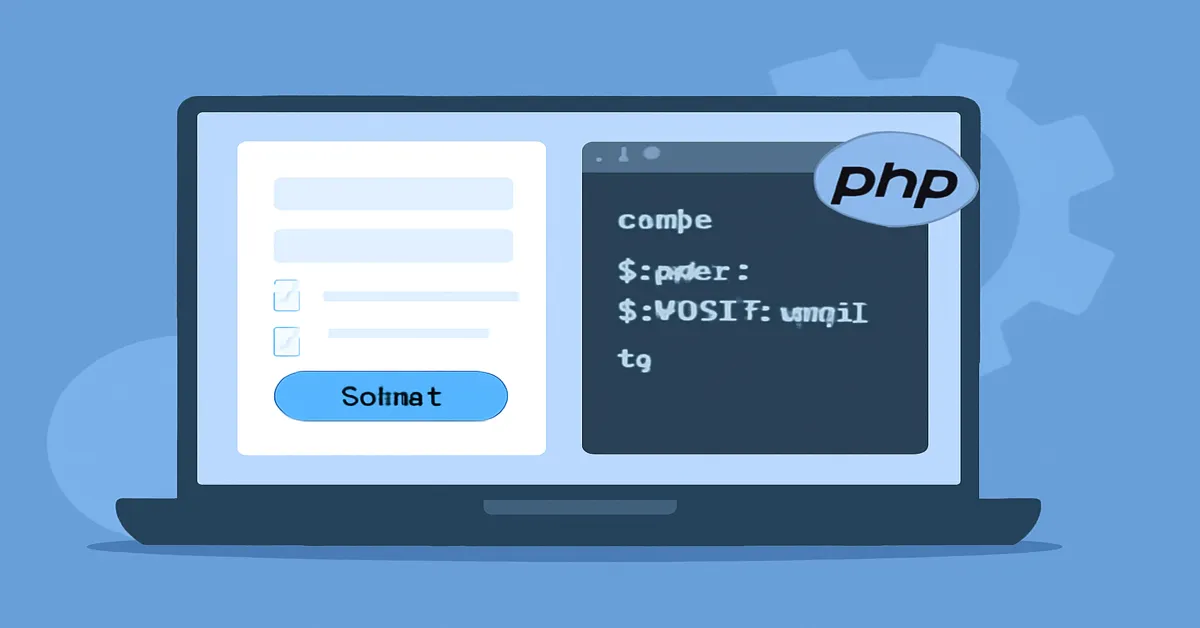When it comes to web development, forms are a fundamental building block. They allow users to interact with websites by submitting data, whether it’s for logging in, submitting feedback, or making a purchase. PHP, as one of the most popular programming languages for server-side scripting, plays a vital role in handling form data. If you’re a beginner looking to understand how to work with forms in PHP, this guide will walk you through the essential concepts, techniques, and best practices.
From creating simple forms to handling user input securely, this article provides a comprehensive introduction to PHP forms. By the end, you will have a solid understanding of form handling, validation, and security considerations, essential for building robust web applications.
1. What is a Form in Web Development?
A form in web development is an HTML element that allows users to submit data to a server for processing. Forms are typically used for collecting user input, such as login credentials, search queries, comments, or other types of data. In PHP, forms are used to collect and process user input, store data in a database, or perform actions based on the data received.
A typical HTML form consists of various input elements like text fields, checkboxes, radio buttons, and submit buttons. When a user submits a form, the data is sent to the server, where PHP processes it.
2. Setting Up the Basic Form in HTML
Before diving into PHP, it’s important to understand how to create a basic form using HTML. The form element is used to create a form in HTML. Here’s an example of a simple form:
htmlCopy<form action="process.php" method="POST">
<label for="name">Name:</label>
<input type="text" id="name" name="name">
<br>
<label for="email">Email:</label>
<input type="email" id="email" name="email">
<br>
<input type="submit" value="Submit">
</form>
- Action Attribute: The
actionattribute specifies the file where the form data will be sent for processing. In this case, the data will be sent toprocess.php. - Method Attribute: The
methodattribute defines how the form data will be sent. Common values areGET(appends data to the URL) andPOST(sends data in the body of the request). For sensitive information, always usePOST. - Input Fields: Input elements like
text,email, andsubmitcollect user data.
In the example above, when the user submits the form, the data will be sent to process.php for processing.
3. Retrieving Form Data with PHP
Once a form is submitted, the data is sent to the server. PHP provides two superglobals, $_GET and $_POST, to retrieve the data from a form. The choice of method (GET or POST) determines whether you use $_GET or $_POST to access the data.
For instance, let’s consider the form from the previous section. After the user submits the form, the data can be accessed using PHP like this:
phpCopy<?php
if ($_SERVER["REQUEST_METHOD"] == "POST") {
$name = $_POST['name'];
$email = $_POST['email'];
echo "Name: " . $name . "<br>";
echo "Email: " . $email;
}
?>
- $_POST: The
$_POSTsuperglobal retrieves data from a form submitted using the POST method. - $_SERVER[“REQUEST_METHOD”]: This checks if the form was submitted using POST.
This code will display the submitted data. However, displaying raw data like this can be risky, so we will cover data validation and sanitization later in the guide.
4. Form Validation and Sanitization
One of the most important aspects of working with forms in PHP is ensuring the data is valid and secure. Form validation checks whether the user has entered the expected data, while sanitization ensures that the data is safe to use, preventing harmful data from entering the application (e.g., preventing cross-site scripting (XSS) attacks).
Basic Validation
Validation can be done using if statements. For example, you might want to ensure that the name and email fields are not empty:
phpCopy<?php
if ($_SERVER["REQUEST_METHOD"] == "POST") {
$name = $_POST['name'];
$email = $_POST['email'];
if (empty($name) || empty($email)) {
echo "Both name and email are required.";
} else {
echo "Name: " . $name . "<br>";
echo "Email: " . $email;
}
}
?>
Sanitizing Data
Sanitizing data is crucial to protect your application from malicious inputs. PHP provides functions like htmlspecialchars() to convert special characters to HTML entities, preventing harmful scripts from executing.
phpCopy<?php
if ($_SERVER["REQUEST_METHOD"] == "POST") {
$name = htmlspecialchars($_POST['name']);
$email = htmlspecialchars($_POST['email']);
echo "Name: " . $name . "<br>";
echo "Email: " . $email;
}
?>
Email Validation
To check if the user has entered a valid email address, you can use PHP’s filter_var() function:
phpCopy<?php
if ($_SERVER["REQUEST_METHOD"] == "POST") {
$email = $_POST['email'];
if (!filter_var($email, FILTER_VALIDATE_EMAIL)) {
echo "Invalid email format";
} else {
echo "Email: " . $email;
}
}
?>
5. Handling File Uploads with Forms
Forms can also be used to upload files. In PHP, handling file uploads requires a few additional steps. Let’s walk through a simple example:
HTML Form for File Upload
htmlCopy<form action="upload.php" method="POST" enctype="multipart/form-data">
<label for="file">Upload File:</label>
<input type="file" id="file" name="file">
<br>
<input type="submit" value="Upload">
</form>
- enctype=”multipart/form-data”: This attribute specifies that the form will send files. Without it, files cannot be uploaded.
- input type=”file”: This input field allows the user to select a file for upload.
PHP Script for File Handling
phpCopy<?php
if ($_SERVER["REQUEST_METHOD"] == "POST") {
if (isset($_FILES['file']) && $_FILES['file']['error'] == 0) {
$fileName = $_FILES['file']['name'];
$fileTmpName = $_FILES['file']['tmp_name'];
$fileSize = $_FILES['file']['size'];
$fileError = $_FILES['file']['error'];
// Check if the file is an image
$fileExt = strtolower(pathinfo($fileName, PATHINFO_EXTENSION));
if (in_array($fileExt, ['jpg', 'jpeg', 'png'])) {
$uploadDir = 'uploads/';
$destination = $uploadDir . basename($fileName);
if (move_uploaded_file($fileTmpName, $destination)) {
echo "File uploaded successfully.";
} else {
echo "There was an error uploading the file.";
}
} else {
echo "Invalid file type. Only JPG, JPEG, and PNG files are allowed.";
}
} else {
echo "No file uploaded or there was an error with the upload.";
}
}
?>
- $_FILES: PHP’s
$_FILESsuperglobal handles file uploads. - move_uploaded_file(): This function moves the uploaded file to a desired location on the server.
Remember to validate and sanitize the uploaded file to avoid security risks like file injection or malicious uploads.
6. Securing Form Data
When dealing with forms, security is paramount. Here are some critical security considerations:
Cross-Site Scripting (XSS)
XSS attacks occur when a malicious user injects scripts into web pages. To prevent XSS, always sanitize user input before displaying it using functions like htmlspecialchars().
Cross-Site Request Forgery (CSRF)
CSRF attacks occur when an attacker tricks a user into performing actions on a website they are authenticated on. To protect against CSRF, use CSRF tokens. These tokens are unique to each session and should be included in every form submission.
Here’s how you can implement CSRF protection:
- Generate a token when the form is first loaded.
- Store it in the user’s session.
- Include the token in the form.
- When the form is submitted, check if the token matches the session token.
phpCopy// Generate CSRF token
session_start();
if (empty($_SESSION['csrf_token'])) {
$_SESSION['csrf_token'] = bin2hex(random_bytes(32));
}
// Include token in form
<form action="process.php" method="POST">
<input type="hidden" name="csrf_token" value="<?php echo $_SESSION['csrf_token']; ?>">
<!-- Other form fields -->
</form>
In the PHP processing script, verify the token:
phpCopyif ($_SERVER["REQUEST_METHOD"] == "POST") {
if (isset($_POST['csrf_token']) && $_POST['csrf_token'] === $_SESSION['csrf_token']) {
// Process form data
} else {
echo "Invalid CSRF token.";
}
}
7. Conclusion
Working with forms in PHP is an essential skill for any web developer. By following this beginner’s guide, you now understand how to create basic forms, retrieve data securely, validate and sanitize user input, handle file uploads, and protect your forms from common security risks.
PHP provides the tools to handle form data efficiently, but it’s important to keep security at the forefront. Proper form validation, sanitization, and security practices, such as CSRF protection and file validation, are key to building robust and secure web applications.
By mastering form handling in PHP, you’ll be able to build powerful, interactive web applications that can process and respond to user input with confidence. Whether you’re developing simple contact forms or complex e-commerce systems, understanding how to work with forms in PHP is an indispensable skill for any web developer.
Read:
The Uses of PHP Programming: A Deep Dive into Its Versatility and Impact on Web Development
A Comprehensive Guide to PHP Books: Your Ultimate Resource for Mastering PHP Programming
Creating a Futuristic Website with PHP: A Step-by-Step Guide for Modern Web Development
Building the Future: How to Create the Best PHP Program for the Next Generation of Developers
Enhancing PHP Coding Efficiency: Techniques, Tools, and Best Practices
FAQs
1. What is the difference between GET and POST methods in PHP forms?
The GET method appends form data to the URL and is typically used for non-sensitive data or search queries. The POST method sends data in the body of the request, making it more secure for submitting sensitive data, such as login credentials or form submissions.
2. How can I validate user input in PHP forms?
You can validate user input in PHP using conditional statements (if) to check for empty fields or incorrect formats. For example, check if an email is valid using filter_var() and ensure mandatory fields are filled. You can also use regular expressions for more complex validation.
3. What is CSRF protection and how do I implement it in PHP?
Cross-Site Request Forgery (CSRF) protection prevents unauthorized actions from being performed on behalf of a user. You can implement CSRF protection by generating a unique token for each form, storing it in the session, and including it as a hidden field in your form. On form submission, check if the token matches the session token.
4. How do I handle file uploads in PHP?
To handle file uploads in PHP, use the $_FILES superglobal to access uploaded files. Ensure that the form includes enctype="multipart/form-data", check the file type and size, and use move_uploaded_file() to move the file to a secure location. Always validate and sanitize file uploads to prevent security risks.
5. How can I protect my PHP forms from XSS attacks?
To protect your PHP forms from Cross-Site Scripting (XSS) attacks, sanitize user input by using the htmlspecialchars() function before displaying the data on the page. This prevents malicious scripts from being executed by converting special characters into HTML entities. Always sanitize any data that comes from untrusted sources.











